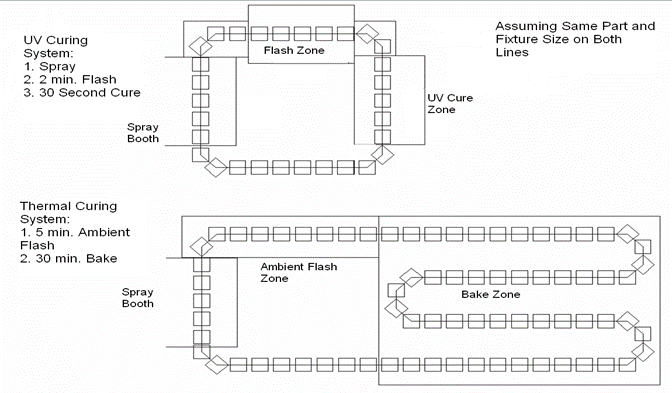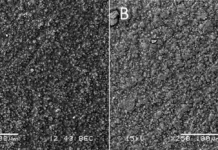By Kristy Wagner, Red Spot Paint and Varnish
Due to their crosslinking capabilities, UV-curable coatings can be natural choices for interior automotive applications. Technologies range from clear to pigmented to physical vapor deposition (PVD) finishes. These coatings provide superior scratch and abrasion resistance as well as the ability to withstand the assault of daily chemicals, lotions and cleaners. In addition, novel properties like anti-fingerprint and anti-microbial continue to expand the opportunities for UV-curable coatings in the industry.
Introduction
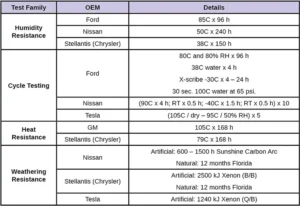
Coatings are being used in almost every aspect of automotive interiors. Predominantly, the coatings are thermally cured – either water- or solvent-based. These technologies have been able to meet the original equipment manufacturers (OEM) specifications, but the demands continuously are evolving and increasing in their performance requirements. Every OEM has its own set of specifications, which will vary in severity and scope of properties. Table 1 shows some of the variations seen in moisture and weathering specifications. Variations exist in the types of tests run as well as the methods used. Some OEMs prefer longer durations at milder conditions, while others will increase the temperature but decrease the exposure time. No matter which OEM is being targeted, a robust formulation is necessary to pass these environmental conditions. While all technologies can be capable of passing these tests, a UV-cured formulation is more likely to pass and still have more to offer.
Weathering requirements for interior automotive coatings also have variations by OEM. Many European manufacturers do not have a weathering specification; domestic and Asian ones do. The variation is not only in duration, but also in the test methods. Ford, GM and Stellantis will use Xenon with Borosilicate / Borosilicate filters. Tesla requires Xenon with Quartz / Borosilicate filters. Nissan specifies Sunshine Carbon Arc over Xenon machines. These machines can affect coatings differently, so knowing which test is required will influence how the coating is formulated. Whether it is the higher heat or the specific UV wavelengths bombarding the surface causing the bigger negative impact, the coating must be able to withstand as many variables as possible to create the most robust system. As a coating supplier, it is beneficial to test to multiple specifications to find any deficiencies in a coating and be able to offer the best-performing coating for as many OEMs as possible.
Due to the extremes in testing conditions, proper formulation for any technology is critical. Some coatings may be able to pass straight heat or moisture tests, but cycle tests, which combine both, can be the downfall. Despite these tough criteria, both UV- and thermally cured technologies can pass most of these tests; however, the Ford thermal shock test has been one of the tougher tests for interior coatings and can cause failures on less robust systems. When properly formulated, thermally cured coatings can pass this test. UV coatings also are capable of meeting this specification, and they can stand above thermally cured technologies in two areas – scratch and chemical resistance.
Because UV-curable coatings can tightly crosslink upon cure, their surface hardness and resiliency tend to be superior to thermally cured coatings. Naturally, the level of this hardness varies from coating to coating; but, in general, UV-cured coatings can be formulated with excellent scratch and chemical resistance. Just as the moisture and weathering specifications vary from OEM to OEM, so do the abrasion and chemical tests. Table 2 shows a sample of abrasion tests and typical results from either a thermally cured or a UV-cured coating.

The five-finger scratch test appears often in OEM specifications. It can be performed as either a standalone test or as a post test for various moisture, heat and/or chemical tests. A variable speed sledge is moved below five independent, weighted scratch “fingers” that are equipped with interchangeable tips. The weights vary from 2N (Newtons) to 20N (Newtons), and the pin can be either 1.0 mm or 7.0 mm in diameter; the smaller pin being the harsher test. As the weight increases, so does the severity of the test; consequently, a test with a 1.0 mm pin and 20N weight would be the harshest setting. Typically, OEMs do not require testing above 13N. However, higher weights can be used to differentiate coatings. It is not uncommon for thermal- and UV-cured coatings to be able to pass a 10N, 7.0 mm pin setting. At the harsher settings, the UV-cured coatings can pass at slightly heavier weights. The interpretation of the tests varies by OEM as well; some require no defect at a specific setting, while others allow for a marring, but no gouging to substrate. Although sometimes subjective, the results from this test can be similar for all chemistries formulated for interior automotive coatings.
The other abrasion tests in Table 2 are measured by gloss retention after testing. Steel wool abrasion is simply rubbing steel wool (typically 0000) back and forth over a coating for a specified number of double rubs (back and forth equals one double rub). For improved reproducibility, the steel wool can be attached to a weighted hammer or other implement to take away the tester’s influence on the severity of the test. The steel wool test is a simple and rapid test to perform with little investment in equipment.
Because of the multiple attachments and settings, the combination of tests that the microscratch tester can perform are almost limitless. Various coarseness of materials can be attached to the swivel head, which itself can vary in size – the coarser the material and the larger the swivel head, the harsher the test. Additionally, liquids can be added to change the nuances of the test. And, of course, the number of cycles can vary. Typically, the harsher the set-up, the fewer the number of cycles. For example, with a thermally cured coating, a test parameter of only two cycles and a 2-micron swivel head can give gloss retention of 70 to 80%. However, a UV coating can maintain 98% gloss retention after 10 cycles and a 9-micron swivel head.
Despite the differences in the test methods, UV-curable coatings consistently can retain greater than 95% gloss across the board. On the other hand, there are definite drop offs with thermally cured coatings. Except for the steel wool test, thermally cured coatings often struggle to retain 80% of the original gloss levels when tested at the same parameters as a UV-cured coating.
Much research and development time is devoted to improving chemical resistance for thermally cured automotive interior coatings, specifically air freshener and sunscreen resistance. Most OEMs will include a version of these tests in their specifications. As with the other performance tests, the parameters can be quite different. Such variables consist of, but are not limited to, time of exposure (one to 24 hours); temperature of exposure (23° to 80° C); product used (Coppertone SPF 30, Deepwoods OFF, Neutrogena Ultra Shear Dry Touch SPF 45, Nivea SPF 47); spot test vs. rub test; and test interpretation (change in appearance, change in hardness and/or loss of adhesion). Table 3 shows test results between a thermally cured coating and a UV-cured coating for some of the harsher OEM chemical resistance tests. Just as with abrasion resistance results, it should come as no surprise that due to the crosslink density of a UV formulation, most chemicals and lotions have little effect on the integrity of the coating.

Other Options for UV-Curable Coatings
The above discussion focused on high-gloss clear coats. While they can play a major part in interior automotive coatings, they are not the only options. Depending on the make and model of the vehicle, other looks are sought. UV-curable technologies not only can be options in these areas; they also may be the preferred choice.
Low Gloss
Depending on what surface is being coated and where that part is located, glare concerns may dictate the coating to be lower gloss. Ultra-low gloss coatings can have issues with marring, burnishing and/or chemical resistance. These problems are less of an issue with UV-curable coatings; however, application viscosity can be a concern if the wrong formulation is used. Many traditional matting agents, at the levels needed to obtain a gloss reading of 1.0, can cause an increase in viscosity of the coating. When these coatings are spray applied, it can be difficult to achieve good atomization and appearance without mottling. Proper additive choice and other formula components are critical to achieving a low-gloss coating that is not too brittle and still passes all the abrasion and chemical testing required.
Piano Black
High-gloss clear coats can be applied directly to substrate for automotive interiors. A high-profile program is the “Piano Black.” Currently this appearance – a high-gloss, high jet black with high depth of image (DOI) – is being achieved with a two-coat system – thermal basecoat and thermal clear coat. UV-curable coatings can offer other options. The simplest switch could be to a UV-curable clear coat. The clear coat would be able to provide a high-gloss, scratch- and chemical-resistant surface finish. This system could be an option for other colors as well, not just Piano Black.
A monocoat system for Piano Black would be the most efficient. However, highly pigmented UV coatings can be a challenge to cure due to the pigment interfering with the photoiniator’s ability to absorb UV light. One compromise can be a dual-cure system. By utilizing both a thermal cure (for shadow areas / enhance depth of cure) and UV curing (surface hardness and gloss), an aesthetic and robust coating can be achieved. Alternatively, with the proper set up and processing, a black tinted UV coating, over a properly molded black substrate, could offer a similar look and offer a monocoat system with no pot life and a decrease in process time. In addition, the coating will maintain all the high-performance characteristics of a UV-curable coating.
Physical Vapor Deposition
Many vehicles contain trim pieces that have been chrome plated. These finishes range from high reflective metals to brushed satin finishes. Because of hexavalent chrome, this process is harmful to the environment. Due to environmental regulations in the United States, much chrome plating has been moved overseas. However, the costs of this process continue to rise. A UV-curable basecoat with a vapor-deposited metal followed with a UV-curable topcoat can solve many of these issues. With PVD metals, no hexavalent chrome is used, thus it does not have negative environmental concerns. A variety of metals can be sputtered – aluminum, chrome, tin, titanium, nickel chrome, stainless steel, etc. – to give the desired look. In addition, the topcoat can be tinted to achieve a nearly endless color palette. This process provides a cost-effective, environmentally friendly, versatile appearance and a robust performing system that will meet all the OEM’s stringent testing requirements for interior automotive coatings.

Enhanced Properties: Anti-Fingerprint

Higher-gloss coatings tend to show more fingerprints. A truly “anti-fingerprint” solution does not exist, but there are options to either reduce the appearance of fingerprints and/or make them easier to remove. The easiest way to mask fingerprints would be to lower the gloss level. The “unevenness” of the surface can disguise the contamination. Of course, this is not an option with a Piano Black system. By increasing the contact angle of a coating, along with other modifications, it can be easier to remove fingerprints and other foulants. Various methods exist to quantify this, but perhaps the most straightforward, is to measure haze of the contaminated surface before and after controlled wiping. By using a standard cloth and pressure, either with or without a cleanser, the spot can be wiped for a specified number of rubs and then the haze can be compared to the pre-cleaned sample. Alternatively, the number of rubs can be counted until the spot is no longer visible. Either technique can demonstrate the coating’s ability to resist fouling and/or decrease cleaning time / effort. Tables 4, 5 and 6 list results from various test methods for traditional UV coatings as well as those modified to improve cleanability of the surface. Because this characteristic is in part due to coating surface chemistry, studies are in process to determine how long these release properties remain viable. Exposure to repeated cleaning, heat and/or moisture could have a detrimental effect on the longevity of this property.

Enhanced Properties: Anti-Microbial

Perhaps the last couple of years have promoted higher-level awareness of good hygiene than any other time in recent history. Worldwide pandemics have shown everyone how important it is to reduce the spread of bacteria and viruses. And while it is very challenging, both from a technical and legal perspective, to promote coatings with anti-viral properties, it is possible to introduce coatings with anti-microbial tendencies. These coatings not only inhibit the growth of harmful bacteria, but the coating performance will not be compromised. Markets such as ride-sharing and public transportation could greatly benefit from high-touch surfaces that prevent the growth of microbes. Table 7 shows the efficacy of a clear coat when exposed to MRSA (gram negative) and E. Coli (gram positive). By testing the ends of the bacterial spectrum, it can be inferred that the coating will be effective against all strains in between. Visually, the modified topcoat does not show a change in gloss or transparency. The application and processing remain the same as well. To confirm that no properties were compromised, several of the harshest OEM tests were performed. As Table 8 shows, the clear coat continues to pass moisture, abrasion and weathering tests and does not exhibit a drop in abrasion resistance. The clear coat could be applied directly to substrate or over a pigmented basecoat and not show a drop in anti-microbial efficacy.
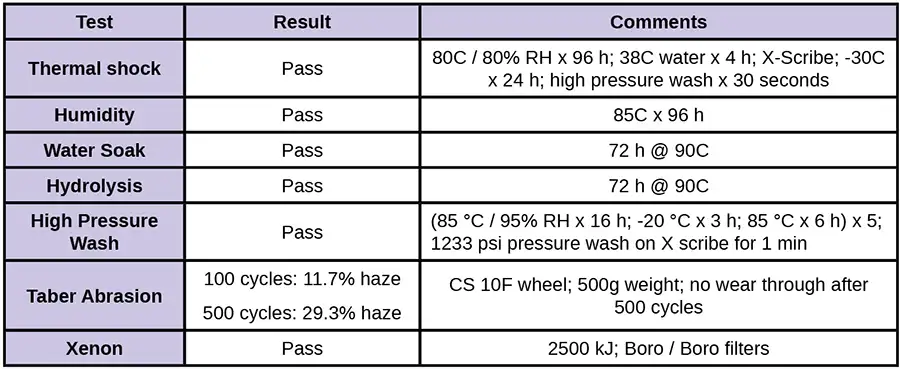
Processing Advantages
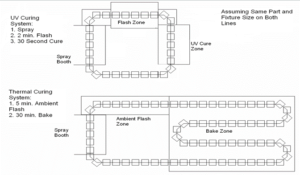
It would be remiss to not mention another major advantage UV formulas have over thermal systems: processing! UV coatings have a much faster cure time than thermally cured coatings. This gives them the advantages of smaller line footprints, lower energy consumption, higher throughput, less work in progress, immediate packing and potentially higher solids / lower VOCs. Upon exposure to UV energy, the curing mechanism takes seconds, not minutes as in a thermal bake. Diagram 1 is a schematic showing the differences in line layouts between a typical UV system and a thermally cured one.
Conclusion
UV-curable clear and pigmented coatings have shown that they not only meet but exceed current original equipment manufacturers’ stringent specifications for Interior Automotive applications. Due to their high crosslink density upon curing, abrasion and chemical resistance can be superior to conventionally cured coatings. Options for physical vapor deposition applications provide a wide aesthetic array while still passing stringent environmental testing. Processing of UV-curable coatings is quicker and requires less floor space than conventionally cured coatings, which will greatly enhance throughput and efficiency. With enhanced properties, like easier to clean and anti-microbial properties, being available without sacrificing coating performance, it becomes clear that UV coatings can be the coating of choice for current and future interior programs.


